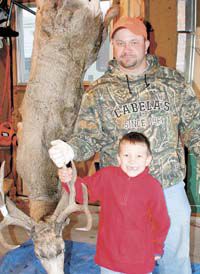| Jerry and Tyler Wright smile giddily with their 5×5 buck taken over the weekend in Price Canyon. |
Utah’s general rifle buck hunt began on Oct. 20 and will conclude on Oct. 24.
But the Utah Division of Wildlife Resources reminds local residents to continue to exercise caution during the remainder of the 2007 season.
According to the DWR, getting prepared by gathering materials and gaining knowledge are two keys to having a safe hunt.
“While taking a deer is usually the highlight of any deer hunt, remember to enjoy all of the experiences a deer hunt provides,” said Lenny Reese, hunter education coordinator for the DWR. “Good friends, a good camp and a chance to see wildlife and the beautiful state we live in are all things you can enjoy during your time afield.”
For personal preparation the DWR recommends:
•Knowing the area to be hunted. If possible scout the area prior to the hunt.
•Putting a survival kit together that includes; a small first aid kit, three quick ways to make a fire (matches, a cigarette lighter, fire starters), quick energy snack foods, a cord or rope, a compass, a flashlight, an extra knife and a small pad of paper and a pencil for keeping track of location.
They also recommend rigorous preparation of the firearm to be used during the hunt.
•Make sure the barrel of the firearm doesn’t have an obstruction in it.
•Make sure to have the proper ammunition for the firearm.
| Hunting Dates General deer season Through Oct. 28 Southeastern region Through Oct. 24 Southern region Through Oct. 24 Muzzleloader elk Nov. 1 to Nov. 9 |
•Be as familiar as possible with the firearm to be used. Know how to load and unload it and where the safety is and how to operate it.
•Controlling the firearm’s muzzle is the most important part of firearm safety. According to the DWR, never let the muzzle of the firearm point at anything that is not a target.
•Never carry a loaded firearm in a vehicle.
•Don’t finger the trigger until the target is in the sights and ready to be shot.
•Before shooting make sure to know what is beyond the target.
For preparing transportation for the hunt many local insurance agency’s warn that October through December is a very high incident season for car collisions.
A Response Insurance press-release cautioned that taking deer crossing road signs seriously could be the difference between life and death.
“More drivers are on the road at dawn and dusk, the very time of day when deer are most active,” said Ray Palermo, director of public relations for Response. “A car striking a 200-pound adult deer can not only result in the death of the deer but also incur an average of $2,000 in damage to the vehicle, aside from possible personal injury.”
The insurance team recommended that motorists scan the road continuously while driving during the current time of the year.
“In many instances, it is best not to swerve around the deer since the deer may move in the same direction. You may also inadvertently hit another vehicle, or go off a dangerous shoulder. Unless certain of the road conditions it is often best to simply brake and continue in your lane of traffic,” said Palermo.
To prepare vehicles for hunting excursions, the DWR recommends:
•Making sure pickup trucks, all-terrain and recreational vehicles are in good mechanical condition.
•Carrying a shovel, ax and tire chains along with jumper cables and an appropriate towing device.
•Staying with the vehicle if experiencing mechanical difficulty or weather problems.
Getting lost is something that has happened to most hunters and taking several precautionary measures will reduce injury risks.
According to DWR, becoming lost is potentially the most dangerous situation a hunter can encounter.
Wildlife officials advise hunters who become lost to avoid panicking, sitting down and building a fire.
“A fire is soothing and it will help you relax and think clearly,” said Reese. “After calming down, try to get your bearings and think your way out of the situation. If you think you know which direction you need to travel, use the pad of paper and pencil from your survival kit and leave a note at your location, indicating who you are and the direction you’re traveling.”
“If you come across other hunters, don’t be embarrassed to stop them and ask for directions and help. If you’re unsure about the direction you should travel, stay at your camp and build a shelter several hours before sundown, if possible. Build a smoky fire which can be spotted from the air. Remaining at your camp is usually a good option. You can survive without food and water for several days,” concluded Reese.

